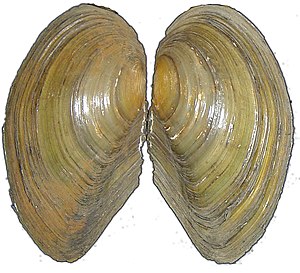River mussel-like
| River mussel-like | ||||||||||||
|---|---|---|---|---|---|---|---|---|---|---|---|---|

Common pond mussel ( Anodonta cf. anatina ) |
||||||||||||
| Systematics | ||||||||||||
|
||||||||||||
| Scientific name | ||||||||||||
| Unionoidea | ||||||||||||
| Rafinesque , 1820 |
The river mussel-like (Unionoidea) are a superfamily of the order Unionida within the mussels . The order Unonoida belongs to the superorder Paleoheterodonta . The first, but still questionable, representatives of the superfamily are known from the Permian , certain representatives from the Triassic . The Unionoidea are probably the sister group of the Etherioidea within the order Unionida.
Characteristic
The superfamily Unionoidea usually have housings of the same flap. The shell consists of two inner layers of mother-of-pearl, a thinner prismatic layer and a thick layer of the organic periostracum . The lock is usually heterodontic , more rarely without teeth. The ligament is usually external. The sphincters are more or less clearly isomyaric , the surface line is integripalliat . A specialty of this group is the "brood care", i. H. the eggs are fertilized in the mantle cavity of the mother animal and mature into a special form of larva, the glochidia . These are released into the open water and only develop in the gills of bottom fish after a parasitic phase.
The representatives of the unionoidea can, if foreign bodies penetrate the mantle space, encapsulate them and form pearls. This has resulted in a certain economic importance in some regions in the past. River pearl mussels can sometimes get very old (up to over 100 years).
Systematics
The classification of the order Unionoidea, like that of the order Unionida, is not yet uniform. This is due to the fact that some malacologists only advocate a subdivision of today's forms into one superfamily, others into two superfamilies.
Superfamily Unionoidea Rafinesque, 1820
- River pearl mussel family (Margaritiferidae Haas, 1940)
- Subfamily Margaritiferinae Haas, 1940
- Margaritifera marrianae ( Alabama pearl mussel )
- Margaritifera margaritifera (European freshwater pearl mussel )
- Margaritifera durrovensis
- Margaritifera hembeli ( Louisiana pearl mussel )
- Margaritifera falcata ( Western freshwater pearl mussel )
- Margaritifera auricularia ( giant river pearl mussel )
- Subfamily Cumberlandinae
- Subfamily Margaritiferinae Haas, 1940
- Family river and pond mussels (Unionidae)
- Subfamily Ambleminae
- Subfamily Lampsilinae
- Subfamily Unioninae
- Genus river mussels ( Unio )
- Unio crassus (river mussel , small river mussel, common river mussel)
- Unio nickliniana
- Unio pictorum ( painter's shell )
- Unio tampicoensis tecomatensis
- Unio tumidus ( large river mussel , inflated river mussel)
- Genus river mussels ( Unio )
- Subfamily Anodontinae
- Genus pond mussels ( Anodonta )
- Anodonta anatina ( common pond clam )
- Anodonta cygnea ( great pond clam )
- Genus Pseudanodonta
- Pseudanodonta complanata ( flattened pond mussel )
- Pseudanodonta elongata ( slender pond clam )
- Pseudanodonta middendorffi ( Danube pond mussel )
- Genus pond mussels ( Anodonta )
There are also three exclusively fossil families whose assignment to the Unionoidea is fraught with great uncertainty:
- † Trigonodidae model, 1942
- † Desertellidae Dechaseaux, 1946
- † Actinodontophoridae Newell, 1969
Large river mussel Unio tumidus
Unio pictorum painter's shell ; Identifying features (parallel top and bottom, side teeth)
literature
- Michael Amler, Rudolf Fischer & Nicole Rogalla: Mussels . Haeckel library, volume 5. Enke Verlag, Stuttgart 2000 ISBN 3-13-118391-8 .
- Rüdiger Bieler & Paula M. Mikkelsen: Bivalvia - a look at the branches . Zoological Journal of the Linnean Society, 148: 223-235, London 2006.
- Daniel L. Graf & Kevin S. Cummings: Palaeoheterodont diversity (Mollusca: Trigonioida + Unionoida): what we know and what we wish we knew about freshwater mussel evolution. Zoological Journal of the Linnean Society, 148: 343-394, London 2006.



